Indiscriminate Use of Social Media and Cyber Bullying among Indigenous Australians
VerifiedAdded on 2023/01/16
|11
|2481
|98
AI Summary
This research aims to understand the role of social media in cyber bullying and social safety among indigenous Australians. It explores the impact of social media on the mental health of indigenous students and the prevalence of cyber bullying in this population.
Contribute Materials
Your contribution can guide someone’s learning journey. Share your
documents today.
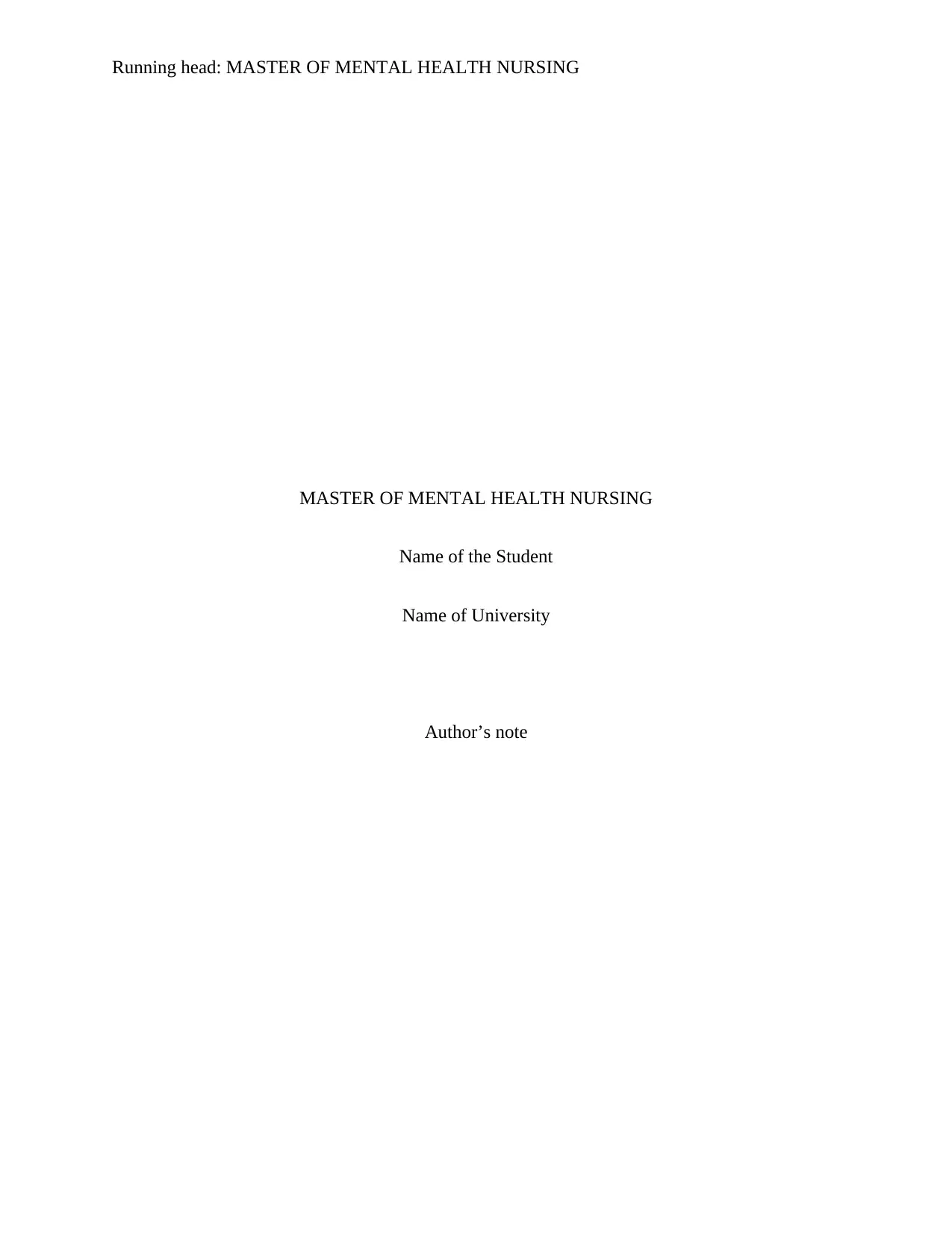
Running head: MASTER OF MENTAL HEALTH NURSING
MASTER OF MENTAL HEALTH NURSING
Name of the Student
Name of University
Author’s note
MASTER OF MENTAL HEALTH NURSING
Name of the Student
Name of University
Author’s note
Secure Best Marks with AI Grader
Need help grading? Try our AI Grader for instant feedback on your assignments.
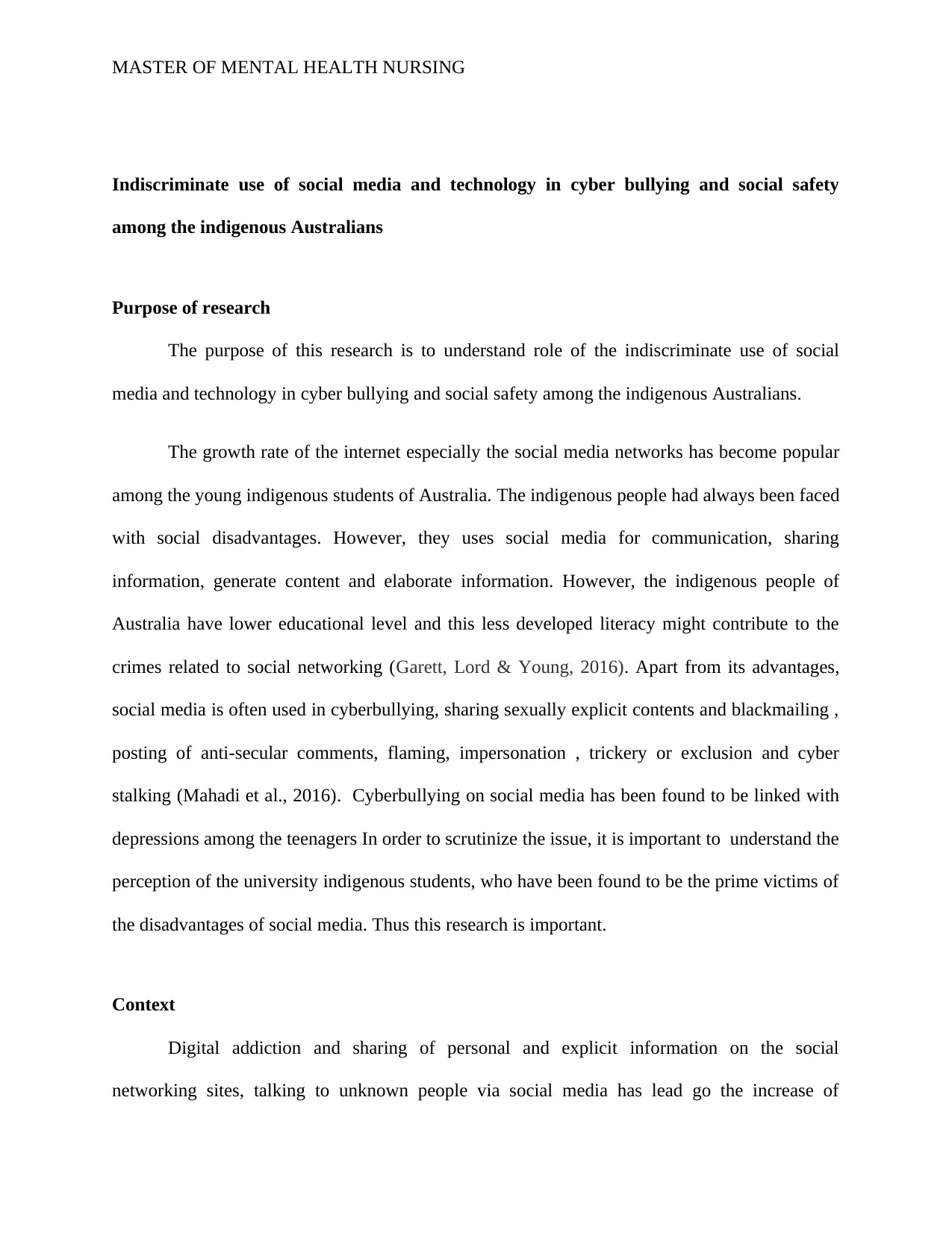
MASTER OF MENTAL HEALTH NURSING
Indiscriminate use of social media and technology in cyber bullying and social safety
among the indigenous Australians
Purpose of research
The purpose of this research is to understand role of the indiscriminate use of social
media and technology in cyber bullying and social safety among the indigenous Australians.
The growth rate of the internet especially the social media networks has become popular
among the young indigenous students of Australia. The indigenous people had always been faced
with social disadvantages. However, they uses social media for communication, sharing
information, generate content and elaborate information. However, the indigenous people of
Australia have lower educational level and this less developed literacy might contribute to the
crimes related to social networking (Garett, Lord & Young, 2016). Apart from its advantages,
social media is often used in cyberbullying, sharing sexually explicit contents and blackmailing ,
posting of anti-secular comments, flaming, impersonation , trickery or exclusion and cyber
stalking (Mahadi et al., 2016). Cyberbullying on social media has been found to be linked with
depressions among the teenagers In order to scrutinize the issue, it is important to understand the
perception of the university indigenous students, who have been found to be the prime victims of
the disadvantages of social media. Thus this research is important.
Context
Digital addiction and sharing of personal and explicit information on the social
networking sites, talking to unknown people via social media has lead go the increase of
Indiscriminate use of social media and technology in cyber bullying and social safety
among the indigenous Australians
Purpose of research
The purpose of this research is to understand role of the indiscriminate use of social
media and technology in cyber bullying and social safety among the indigenous Australians.
The growth rate of the internet especially the social media networks has become popular
among the young indigenous students of Australia. The indigenous people had always been faced
with social disadvantages. However, they uses social media for communication, sharing
information, generate content and elaborate information. However, the indigenous people of
Australia have lower educational level and this less developed literacy might contribute to the
crimes related to social networking (Garett, Lord & Young, 2016). Apart from its advantages,
social media is often used in cyberbullying, sharing sexually explicit contents and blackmailing ,
posting of anti-secular comments, flaming, impersonation , trickery or exclusion and cyber
stalking (Mahadi et al., 2016). Cyberbullying on social media has been found to be linked with
depressions among the teenagers In order to scrutinize the issue, it is important to understand the
perception of the university indigenous students, who have been found to be the prime victims of
the disadvantages of social media. Thus this research is important.
Context
Digital addiction and sharing of personal and explicit information on the social
networking sites, talking to unknown people via social media has lead go the increase of
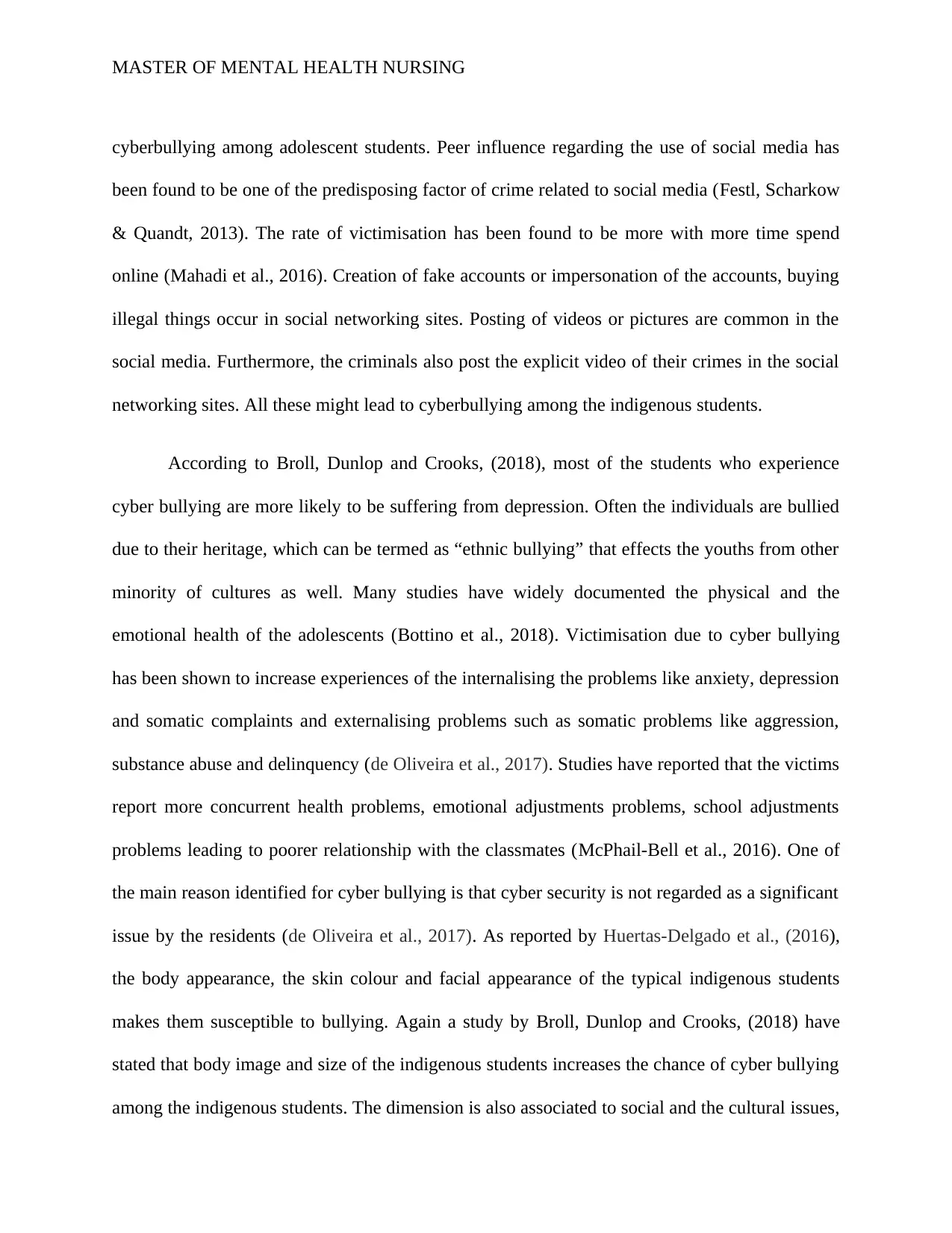
MASTER OF MENTAL HEALTH NURSING
cyberbullying among adolescent students. Peer influence regarding the use of social media has
been found to be one of the predisposing factor of crime related to social media (Festl, Scharkow
& Quandt, 2013). The rate of victimisation has been found to be more with more time spend
online (Mahadi et al., 2016). Creation of fake accounts or impersonation of the accounts, buying
illegal things occur in social networking sites. Posting of videos or pictures are common in the
social media. Furthermore, the criminals also post the explicit video of their crimes in the social
networking sites. All these might lead to cyberbullying among the indigenous students.
According to Broll, Dunlop and Crooks, (2018), most of the students who experience
cyber bullying are more likely to be suffering from depression. Often the individuals are bullied
due to their heritage, which can be termed as “ethnic bullying” that effects the youths from other
minority of cultures as well. Many studies have widely documented the physical and the
emotional health of the adolescents (Bottino et al., 2018). Victimisation due to cyber bullying
has been shown to increase experiences of the internalising the problems like anxiety, depression
and somatic complaints and externalising problems such as somatic problems like aggression,
substance abuse and delinquency (de Oliveira et al., 2017). Studies have reported that the victims
report more concurrent health problems, emotional adjustments problems, school adjustments
problems leading to poorer relationship with the classmates (McPhail-Bell et al., 2016). One of
the main reason identified for cyber bullying is that cyber security is not regarded as a significant
issue by the residents (de Oliveira et al., 2017). As reported by Huertas-Delgado et al., (2016),
the body appearance, the skin colour and facial appearance of the typical indigenous students
makes them susceptible to bullying. Again a study by Broll, Dunlop and Crooks, (2018) have
stated that body image and size of the indigenous students increases the chance of cyber bullying
among the indigenous students. The dimension is also associated to social and the cultural issues,
cyberbullying among adolescent students. Peer influence regarding the use of social media has
been found to be one of the predisposing factor of crime related to social media (Festl, Scharkow
& Quandt, 2013). The rate of victimisation has been found to be more with more time spend
online (Mahadi et al., 2016). Creation of fake accounts or impersonation of the accounts, buying
illegal things occur in social networking sites. Posting of videos or pictures are common in the
social media. Furthermore, the criminals also post the explicit video of their crimes in the social
networking sites. All these might lead to cyberbullying among the indigenous students.
According to Broll, Dunlop and Crooks, (2018), most of the students who experience
cyber bullying are more likely to be suffering from depression. Often the individuals are bullied
due to their heritage, which can be termed as “ethnic bullying” that effects the youths from other
minority of cultures as well. Many studies have widely documented the physical and the
emotional health of the adolescents (Bottino et al., 2018). Victimisation due to cyber bullying
has been shown to increase experiences of the internalising the problems like anxiety, depression
and somatic complaints and externalising problems such as somatic problems like aggression,
substance abuse and delinquency (de Oliveira et al., 2017). Studies have reported that the victims
report more concurrent health problems, emotional adjustments problems, school adjustments
problems leading to poorer relationship with the classmates (McPhail-Bell et al., 2016). One of
the main reason identified for cyber bullying is that cyber security is not regarded as a significant
issue by the residents (de Oliveira et al., 2017). As reported by Huertas-Delgado et al., (2016),
the body appearance, the skin colour and facial appearance of the typical indigenous students
makes them susceptible to bullying. Again a study by Broll, Dunlop and Crooks, (2018) have
stated that body image and size of the indigenous students increases the chance of cyber bullying
among the indigenous students. The dimension is also associated to social and the cultural issues,
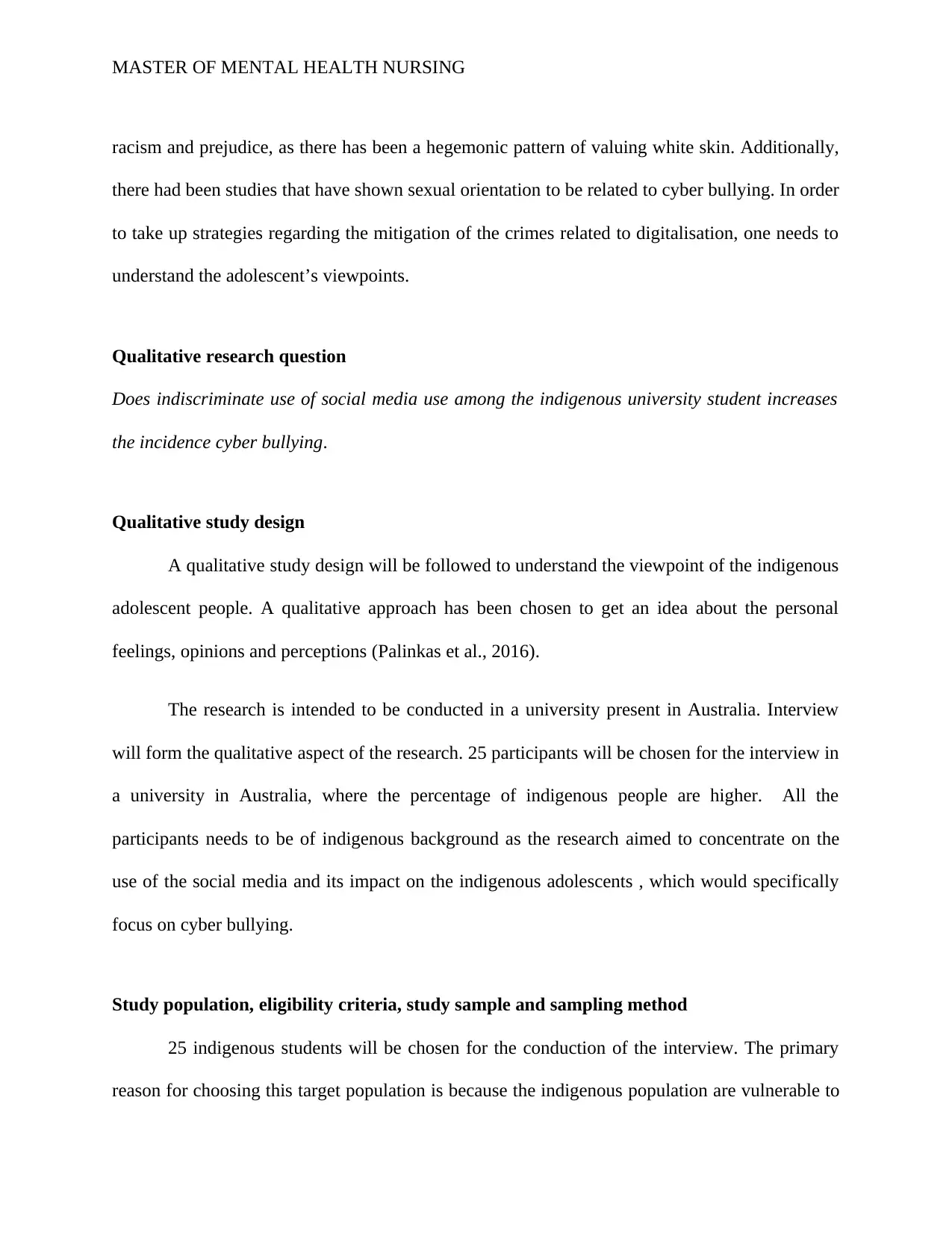
MASTER OF MENTAL HEALTH NURSING
racism and prejudice, as there has been a hegemonic pattern of valuing white skin. Additionally,
there had been studies that have shown sexual orientation to be related to cyber bullying. In order
to take up strategies regarding the mitigation of the crimes related to digitalisation, one needs to
understand the adolescent’s viewpoints.
Qualitative research question
Does indiscriminate use of social media use among the indigenous university student increases
the incidence cyber bullying.
Qualitative study design
A qualitative study design will be followed to understand the viewpoint of the indigenous
adolescent people. A qualitative approach has been chosen to get an idea about the personal
feelings, opinions and perceptions (Palinkas et al., 2016).
The research is intended to be conducted in a university present in Australia. Interview
will form the qualitative aspect of the research. 25 participants will be chosen for the interview in
a university in Australia, where the percentage of indigenous people are higher. All the
participants needs to be of indigenous background as the research aimed to concentrate on the
use of the social media and its impact on the indigenous adolescents , which would specifically
focus on cyber bullying.
Study population, eligibility criteria, study sample and sampling method
25 indigenous students will be chosen for the conduction of the interview. The primary
reason for choosing this target population is because the indigenous population are vulnerable to
racism and prejudice, as there has been a hegemonic pattern of valuing white skin. Additionally,
there had been studies that have shown sexual orientation to be related to cyber bullying. In order
to take up strategies regarding the mitigation of the crimes related to digitalisation, one needs to
understand the adolescent’s viewpoints.
Qualitative research question
Does indiscriminate use of social media use among the indigenous university student increases
the incidence cyber bullying.
Qualitative study design
A qualitative study design will be followed to understand the viewpoint of the indigenous
adolescent people. A qualitative approach has been chosen to get an idea about the personal
feelings, opinions and perceptions (Palinkas et al., 2016).
The research is intended to be conducted in a university present in Australia. Interview
will form the qualitative aspect of the research. 25 participants will be chosen for the interview in
a university in Australia, where the percentage of indigenous people are higher. All the
participants needs to be of indigenous background as the research aimed to concentrate on the
use of the social media and its impact on the indigenous adolescents , which would specifically
focus on cyber bullying.
Study population, eligibility criteria, study sample and sampling method
25 indigenous students will be chosen for the conduction of the interview. The primary
reason for choosing this target population is because the indigenous population are vulnerable to
Secure Best Marks with AI Grader
Need help grading? Try our AI Grader for instant feedback on your assignments.
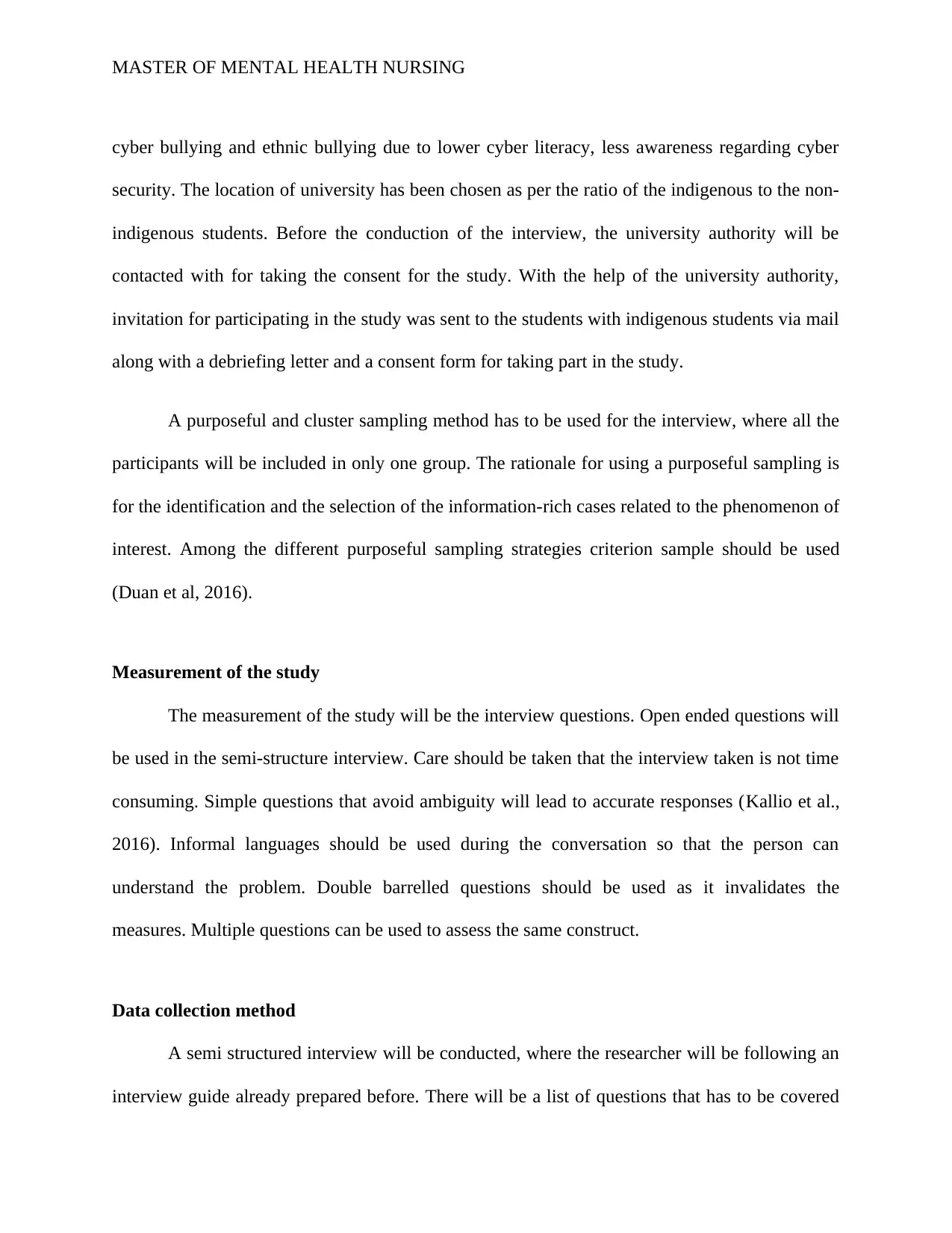
MASTER OF MENTAL HEALTH NURSING
cyber bullying and ethnic bullying due to lower cyber literacy, less awareness regarding cyber
security. The location of university has been chosen as per the ratio of the indigenous to the non-
indigenous students. Before the conduction of the interview, the university authority will be
contacted with for taking the consent for the study. With the help of the university authority,
invitation for participating in the study was sent to the students with indigenous students via mail
along with a debriefing letter and a consent form for taking part in the study.
A purposeful and cluster sampling method has to be used for the interview, where all the
participants will be included in only one group. The rationale for using a purposeful sampling is
for the identification and the selection of the information-rich cases related to the phenomenon of
interest. Among the different purposeful sampling strategies criterion sample should be used
(Duan et al, 2016).
Measurement of the study
The measurement of the study will be the interview questions. Open ended questions will
be used in the semi-structure interview. Care should be taken that the interview taken is not time
consuming. Simple questions that avoid ambiguity will lead to accurate responses (Kallio et al.,
2016). Informal languages should be used during the conversation so that the person can
understand the problem. Double barrelled questions should be used as it invalidates the
measures. Multiple questions can be used to assess the same construct.
Data collection method
A semi structured interview will be conducted, where the researcher will be following an
interview guide already prepared before. There will be a list of questions that has to be covered
cyber bullying and ethnic bullying due to lower cyber literacy, less awareness regarding cyber
security. The location of university has been chosen as per the ratio of the indigenous to the non-
indigenous students. Before the conduction of the interview, the university authority will be
contacted with for taking the consent for the study. With the help of the university authority,
invitation for participating in the study was sent to the students with indigenous students via mail
along with a debriefing letter and a consent form for taking part in the study.
A purposeful and cluster sampling method has to be used for the interview, where all the
participants will be included in only one group. The rationale for using a purposeful sampling is
for the identification and the selection of the information-rich cases related to the phenomenon of
interest. Among the different purposeful sampling strategies criterion sample should be used
(Duan et al, 2016).
Measurement of the study
The measurement of the study will be the interview questions. Open ended questions will
be used in the semi-structure interview. Care should be taken that the interview taken is not time
consuming. Simple questions that avoid ambiguity will lead to accurate responses (Kallio et al.,
2016). Informal languages should be used during the conversation so that the person can
understand the problem. Double barrelled questions should be used as it invalidates the
measures. Multiple questions can be used to assess the same construct.
Data collection method
A semi structured interview will be conducted, where the researcher will be following an
interview guide already prepared before. There will be a list of questions that has to be covered

MASTER OF MENTAL HEALTH NURSING
in during the conversation, in a particular order. The participants will be allowed to present their
ideas on specific question related to the research question. , thus facilitating a deeper awareness
of the larger population. Semi structured interview has been found to be the best method, if the
interviewer won’t get a second chance to interview the person. The responds from the
participants will be recorded by using an electronic recorder.
Rigor, trustworthiness and study limitations
Demonstration of rigor in a qualitative study is important such that the research finding
have the integrity for making an impact on the practice policy or both. This would ensure a good
quality of the qualitative research (Hadi & Closs, 2016).
The estimated study limitation is low sample size and the sampling procedure used. It
should be mentioned that only indigenous students has been selected for the study and non-
indigenous students has not been selected. Furthermore, since participants have been selected
from only one college. This would hamper the generalizability of the results. Again cyber
related crime and psychological issues are not only faced by the indigenous students and are also
experienced by the non –indigenous counterparts. Again, some of the common interview biases
includes preconceived ideas and beliefs, impacts of other factors like academic and peer pressure
that might have contributed to the psychological issue among the respondents. Another probable
bias that can contribute is the response bias, for example the students might not give correct
answers or they might give answers that are acceptable socially.
in during the conversation, in a particular order. The participants will be allowed to present their
ideas on specific question related to the research question. , thus facilitating a deeper awareness
of the larger population. Semi structured interview has been found to be the best method, if the
interviewer won’t get a second chance to interview the person. The responds from the
participants will be recorded by using an electronic recorder.
Rigor, trustworthiness and study limitations
Demonstration of rigor in a qualitative study is important such that the research finding
have the integrity for making an impact on the practice policy or both. This would ensure a good
quality of the qualitative research (Hadi & Closs, 2016).
The estimated study limitation is low sample size and the sampling procedure used. It
should be mentioned that only indigenous students has been selected for the study and non-
indigenous students has not been selected. Furthermore, since participants have been selected
from only one college. This would hamper the generalizability of the results. Again cyber
related crime and psychological issues are not only faced by the indigenous students and are also
experienced by the non –indigenous counterparts. Again, some of the common interview biases
includes preconceived ideas and beliefs, impacts of other factors like academic and peer pressure
that might have contributed to the psychological issue among the respondents. Another probable
bias that can contribute is the response bias, for example the students might not give correct
answers or they might give answers that are acceptable socially.
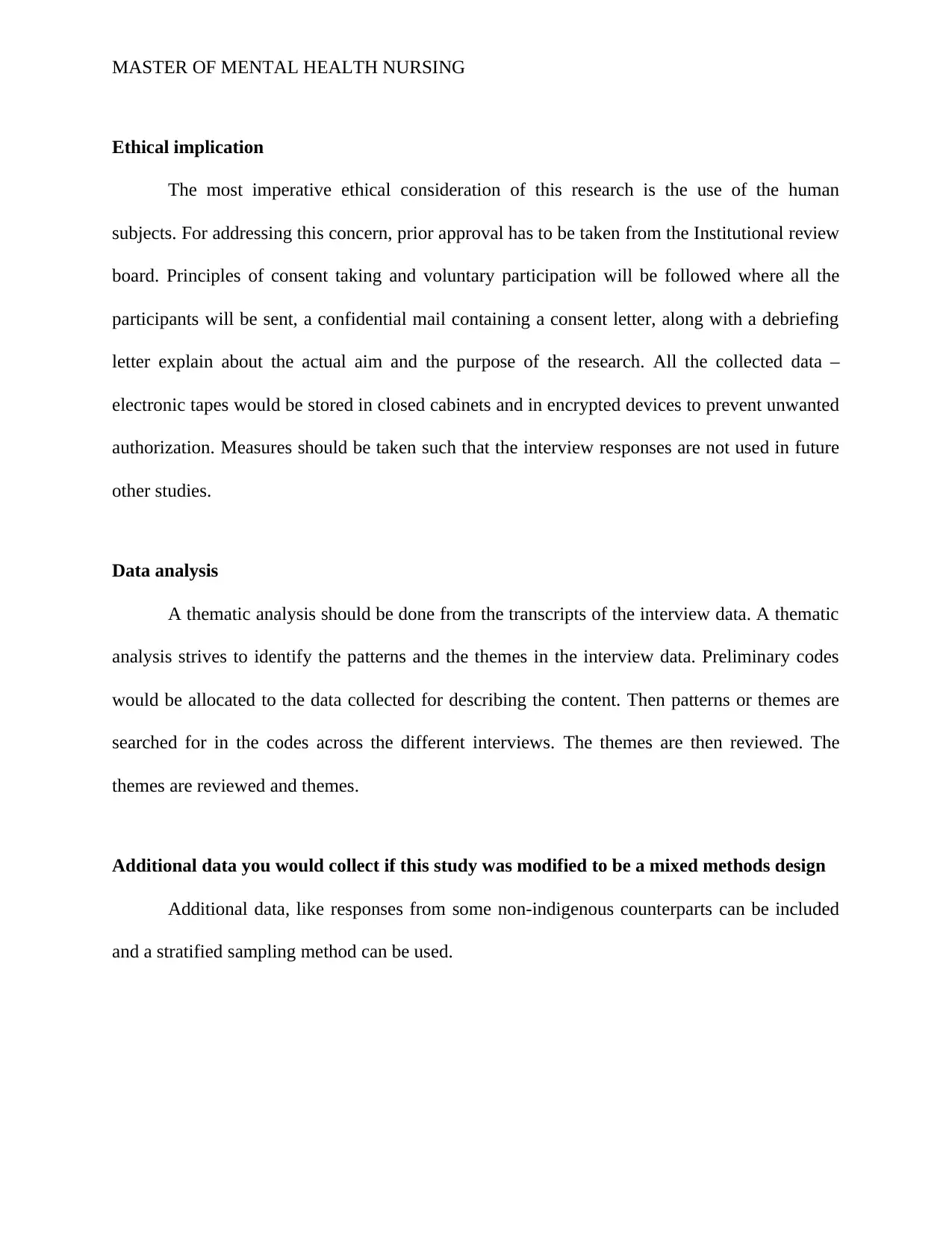
MASTER OF MENTAL HEALTH NURSING
Ethical implication
The most imperative ethical consideration of this research is the use of the human
subjects. For addressing this concern, prior approval has to be taken from the Institutional review
board. Principles of consent taking and voluntary participation will be followed where all the
participants will be sent, a confidential mail containing a consent letter, along with a debriefing
letter explain about the actual aim and the purpose of the research. All the collected data –
electronic tapes would be stored in closed cabinets and in encrypted devices to prevent unwanted
authorization. Measures should be taken such that the interview responses are not used in future
other studies.
Data analysis
A thematic analysis should be done from the transcripts of the interview data. A thematic
analysis strives to identify the patterns and the themes in the interview data. Preliminary codes
would be allocated to the data collected for describing the content. Then patterns or themes are
searched for in the codes across the different interviews. The themes are then reviewed. The
themes are reviewed and themes.
Additional data you would collect if this study was modified to be a mixed methods design
Additional data, like responses from some non-indigenous counterparts can be included
and a stratified sampling method can be used.
Ethical implication
The most imperative ethical consideration of this research is the use of the human
subjects. For addressing this concern, prior approval has to be taken from the Institutional review
board. Principles of consent taking and voluntary participation will be followed where all the
participants will be sent, a confidential mail containing a consent letter, along with a debriefing
letter explain about the actual aim and the purpose of the research. All the collected data –
electronic tapes would be stored in closed cabinets and in encrypted devices to prevent unwanted
authorization. Measures should be taken such that the interview responses are not used in future
other studies.
Data analysis
A thematic analysis should be done from the transcripts of the interview data. A thematic
analysis strives to identify the patterns and the themes in the interview data. Preliminary codes
would be allocated to the data collected for describing the content. Then patterns or themes are
searched for in the codes across the different interviews. The themes are then reviewed. The
themes are reviewed and themes.
Additional data you would collect if this study was modified to be a mixed methods design
Additional data, like responses from some non-indigenous counterparts can be included
and a stratified sampling method can be used.
Paraphrase This Document
Need a fresh take? Get an instant paraphrase of this document with our AI Paraphraser

MASTER OF MENTAL HEALTH NURSING
What methods would you use?
Surveys containing closed –ended questions can be used in the study to give it a mixed
method approach. A survey questionnaire should be used and will be distributed to all the
students participated. Collection and the analysis of both closed ended and open ended questions
would help in the promotion of more synergistic and complete utilization of the data than to use
only qualitative and quantitative data collection. Statistical analysis of the data will be conducted
by using SPSS.
What methods would you use?
Surveys containing closed –ended questions can be used in the study to give it a mixed
method approach. A survey questionnaire should be used and will be distributed to all the
students participated. Collection and the analysis of both closed ended and open ended questions
would help in the promotion of more synergistic and complete utilization of the data than to use
only qualitative and quantitative data collection. Statistical analysis of the data will be conducted
by using SPSS.
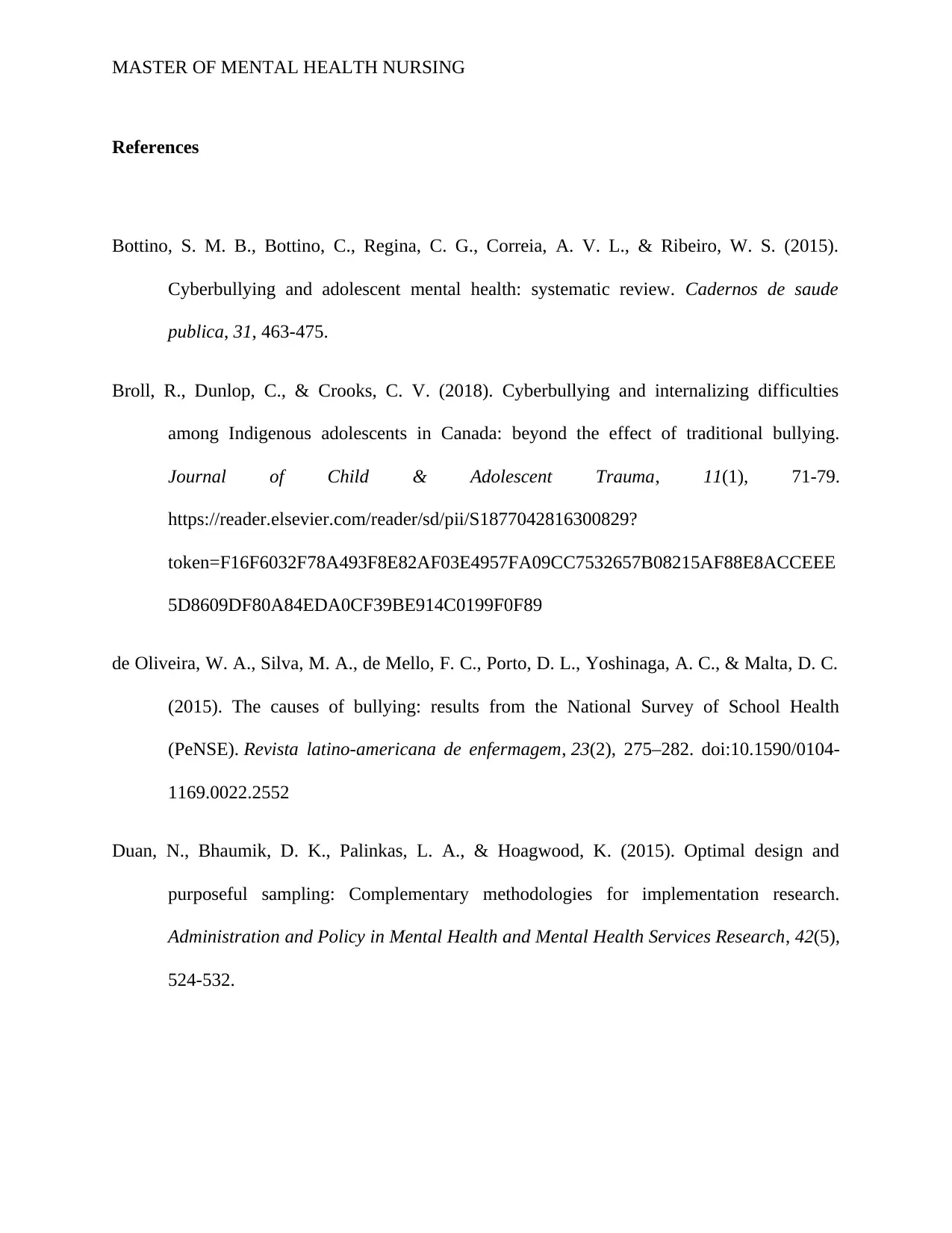
MASTER OF MENTAL HEALTH NURSING
References
Bottino, S. M. B., Bottino, C., Regina, C. G., Correia, A. V. L., & Ribeiro, W. S. (2015).
Cyberbullying and adolescent mental health: systematic review. Cadernos de saude
publica, 31, 463-475.
Broll, R., Dunlop, C., & Crooks, C. V. (2018). Cyberbullying and internalizing difficulties
among Indigenous adolescents in Canada: beyond the effect of traditional bullying.
Journal of Child & Adolescent Trauma, 11(1), 71-79.
https://reader.elsevier.com/reader/sd/pii/S1877042816300829?
token=F16F6032F78A493F8E82AF03E4957FA09CC7532657B08215AF88E8ACCEEE
5D8609DF80A84EDA0CF39BE914C0199F0F89
de Oliveira, W. A., Silva, M. A., de Mello, F. C., Porto, D. L., Yoshinaga, A. C., & Malta, D. C.
(2015). The causes of bullying: results from the National Survey of School Health
(PeNSE). Revista latino-americana de enfermagem, 23(2), 275–282. doi:10.1590/0104-
1169.0022.2552
Duan, N., Bhaumik, D. K., Palinkas, L. A., & Hoagwood, K. (2015). Optimal design and
purposeful sampling: Complementary methodologies for implementation research.
Administration and Policy in Mental Health and Mental Health Services Research, 42(5),
524-532.
References
Bottino, S. M. B., Bottino, C., Regina, C. G., Correia, A. V. L., & Ribeiro, W. S. (2015).
Cyberbullying and adolescent mental health: systematic review. Cadernos de saude
publica, 31, 463-475.
Broll, R., Dunlop, C., & Crooks, C. V. (2018). Cyberbullying and internalizing difficulties
among Indigenous adolescents in Canada: beyond the effect of traditional bullying.
Journal of Child & Adolescent Trauma, 11(1), 71-79.
https://reader.elsevier.com/reader/sd/pii/S1877042816300829?
token=F16F6032F78A493F8E82AF03E4957FA09CC7532657B08215AF88E8ACCEEE
5D8609DF80A84EDA0CF39BE914C0199F0F89
de Oliveira, W. A., Silva, M. A., de Mello, F. C., Porto, D. L., Yoshinaga, A. C., & Malta, D. C.
(2015). The causes of bullying: results from the National Survey of School Health
(PeNSE). Revista latino-americana de enfermagem, 23(2), 275–282. doi:10.1590/0104-
1169.0022.2552
Duan, N., Bhaumik, D. K., Palinkas, L. A., & Hoagwood, K. (2015). Optimal design and
purposeful sampling: Complementary methodologies for implementation research.
Administration and Policy in Mental Health and Mental Health Services Research, 42(5),
524-532.
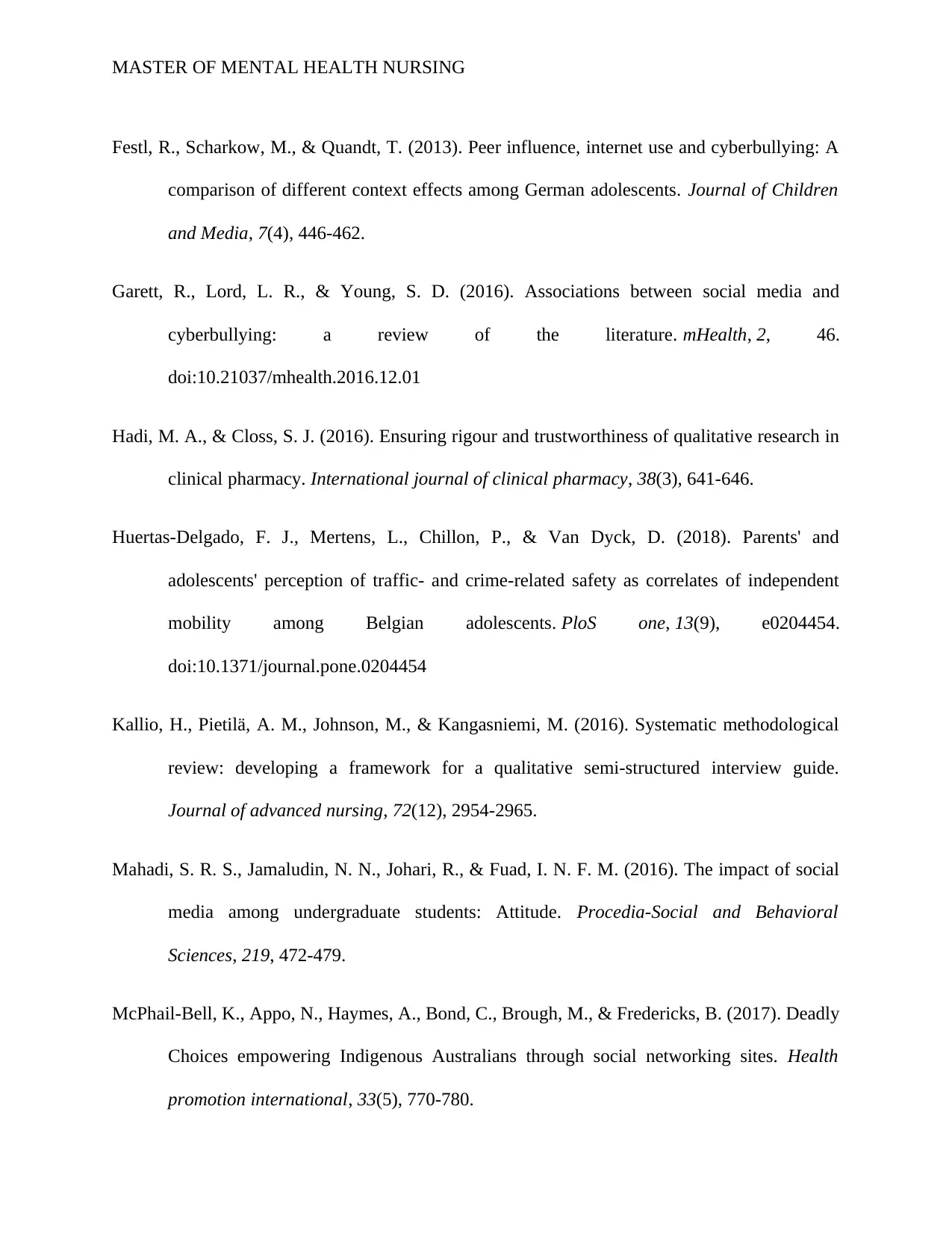
MASTER OF MENTAL HEALTH NURSING
Festl, R., Scharkow, M., & Quandt, T. (2013). Peer influence, internet use and cyberbullying: A
comparison of different context effects among German adolescents. Journal of Children
and Media, 7(4), 446-462.
Garett, R., Lord, L. R., & Young, S. D. (2016). Associations between social media and
cyberbullying: a review of the literature. mHealth, 2, 46.
doi:10.21037/mhealth.2016.12.01
Hadi, M. A., & Closs, S. J. (2016). Ensuring rigour and trustworthiness of qualitative research in
clinical pharmacy. International journal of clinical pharmacy, 38(3), 641-646.
Huertas-Delgado, F. J., Mertens, L., Chillon, P., & Van Dyck, D. (2018). Parents' and
adolescents' perception of traffic- and crime-related safety as correlates of independent
mobility among Belgian adolescents. PloS one, 13(9), e0204454.
doi:10.1371/journal.pone.0204454
Kallio, H., Pietilä, A. M., Johnson, M., & Kangasniemi, M. (2016). Systematic methodological
review: developing a framework for a qualitative semi‐structured interview guide.
Journal of advanced nursing, 72(12), 2954-2965.
Mahadi, S. R. S., Jamaludin, N. N., Johari, R., & Fuad, I. N. F. M. (2016). The impact of social
media among undergraduate students: Attitude. Procedia-Social and Behavioral
Sciences, 219, 472-479.
McPhail-Bell, K., Appo, N., Haymes, A., Bond, C., Brough, M., & Fredericks, B. (2017). Deadly
Choices empowering Indigenous Australians through social networking sites. Health
promotion international, 33(5), 770-780.
Festl, R., Scharkow, M., & Quandt, T. (2013). Peer influence, internet use and cyberbullying: A
comparison of different context effects among German adolescents. Journal of Children
and Media, 7(4), 446-462.
Garett, R., Lord, L. R., & Young, S. D. (2016). Associations between social media and
cyberbullying: a review of the literature. mHealth, 2, 46.
doi:10.21037/mhealth.2016.12.01
Hadi, M. A., & Closs, S. J. (2016). Ensuring rigour and trustworthiness of qualitative research in
clinical pharmacy. International journal of clinical pharmacy, 38(3), 641-646.
Huertas-Delgado, F. J., Mertens, L., Chillon, P., & Van Dyck, D. (2018). Parents' and
adolescents' perception of traffic- and crime-related safety as correlates of independent
mobility among Belgian adolescents. PloS one, 13(9), e0204454.
doi:10.1371/journal.pone.0204454
Kallio, H., Pietilä, A. M., Johnson, M., & Kangasniemi, M. (2016). Systematic methodological
review: developing a framework for a qualitative semi‐structured interview guide.
Journal of advanced nursing, 72(12), 2954-2965.
Mahadi, S. R. S., Jamaludin, N. N., Johari, R., & Fuad, I. N. F. M. (2016). The impact of social
media among undergraduate students: Attitude. Procedia-Social and Behavioral
Sciences, 219, 472-479.
McPhail-Bell, K., Appo, N., Haymes, A., Bond, C., Brough, M., & Fredericks, B. (2017). Deadly
Choices empowering Indigenous Australians through social networking sites. Health
promotion international, 33(5), 770-780.
Secure Best Marks with AI Grader
Need help grading? Try our AI Grader for instant feedback on your assignments.

MASTER OF MENTAL HEALTH NURSING
Palinkas LA, Horwitz SM, Green CA, Wisdom JP, Duan N, Hoagwood K. Purposeful Sampling
for Qualitative Data Collection and Analysis in Mixed Method Implementation Research.
Adm Policy Ment Health. 2015 Sep;42(5):533-44. doi: 10.1007/s10488-013-0528-y.
PubMed PMID: 24193818; PubMed Central PMCID: PMC4012002.
Palinkas LA, Horwitz SM, Green CA, Wisdom JP, Duan N, Hoagwood K. Purposeful Sampling
for Qualitative Data Collection and Analysis in Mixed Method Implementation Research.
Adm Policy Ment Health. 2015 Sep;42(5):533-44. doi: 10.1007/s10488-013-0528-y.
PubMed PMID: 24193818; PubMed Central PMCID: PMC4012002.
1 out of 11
Related Documents
Your All-in-One AI-Powered Toolkit for Academic Success.
+13062052269
info@desklib.com
Available 24*7 on WhatsApp / Email
![[object Object]](/_next/static/media/star-bottom.7253800d.svg)
Unlock your academic potential
© 2024 | Zucol Services PVT LTD | All rights reserved.





